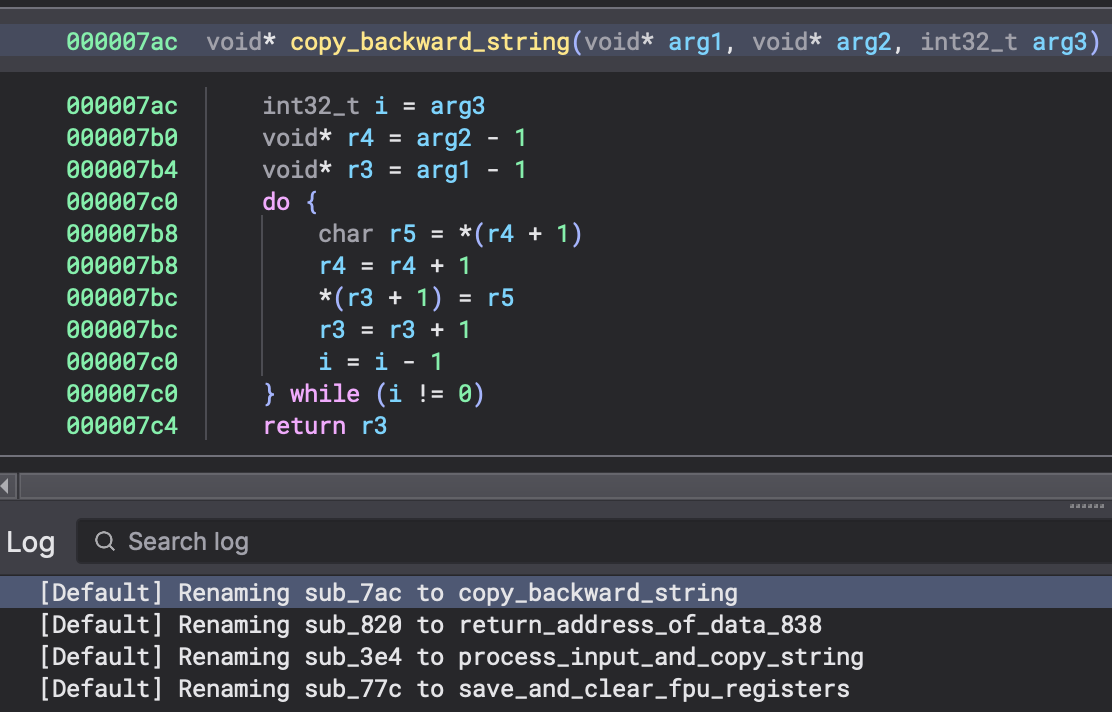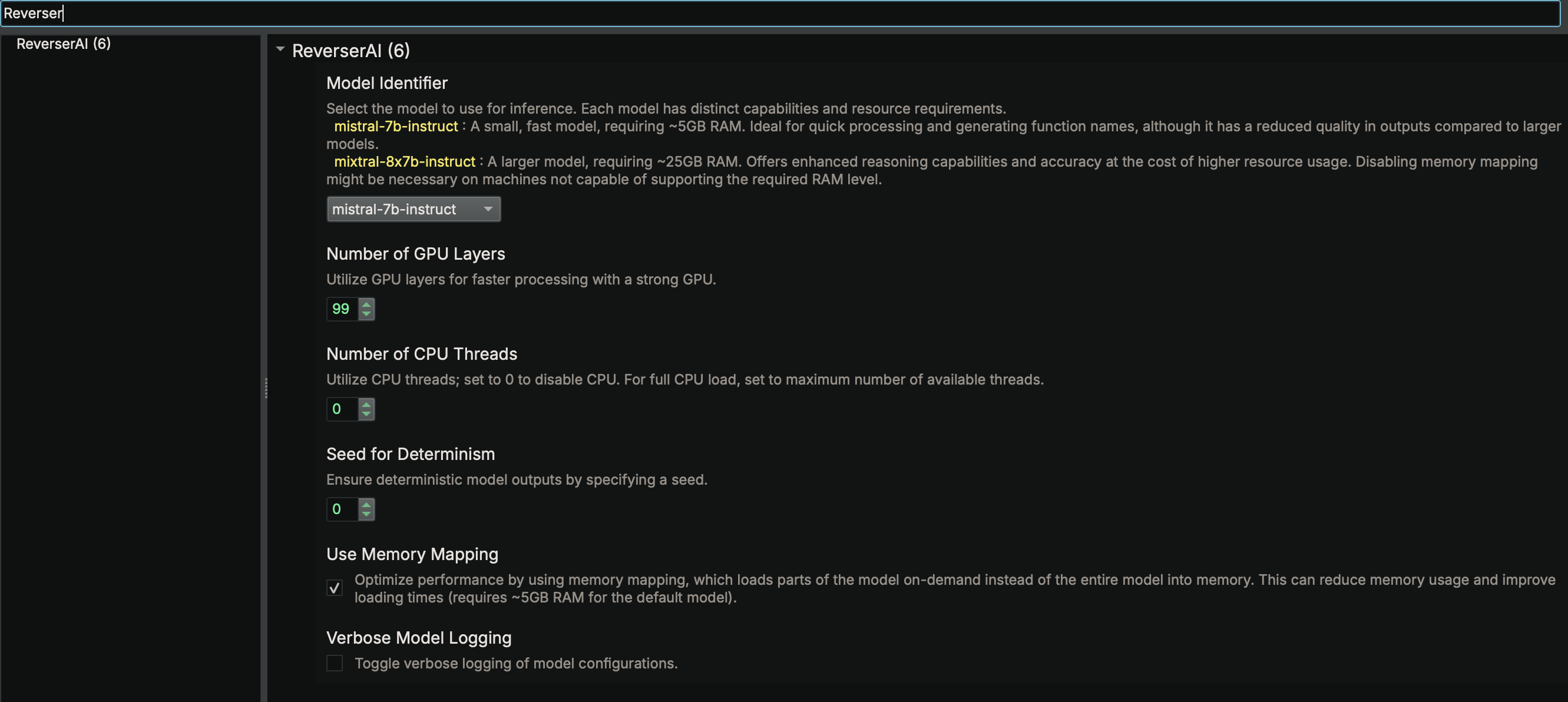Author: Tim Blazytko
Provides automated reverse engineering assistance through the use of local large language models (LLMs) on consumer hardware.
ReverserAI is a research project designed to automate and enhance reverse engineering tasks through the use of locally-hosted large language models (LLMs). Operating entirely offline, this initial release features the automatic suggestion of high-level, semantically meaningful function names derived from decompiler output. ReverserAI is provided as a Binary Ninja plugin; however, its architecture is designed to be extended to other reverse engineering platforms such as IDA and Ghidra.
While local LLMs do not match the performance and capabilities of their cloud-based counterparts like ChatGPT4 and require substantial computing resources, they represent a significant step forward in balancing performance with confidentiality requirements.
ReverserAI serves as an initial exploration into the potential of local LLMs as aids in reverse engineering on consumer-grade hardware. It showcases what is currently achievable and plans to be a playground for future developments in the realm of AI-assisted reverse engineering. Additionally, the project explores the benefits of combining static analysis techniques with modern AI capabilities to improve the accuracy of AI-assisted reverse engineering.
Some example use cases can be found in examples.
Note
Disclaimer: My expertise in machine learning and LLMs is limited. There may exist more efficient models or methods to achieve similar tasks with greater performance. This project represents a culmination of research into viable configurations, offering a stable foundation with acceptable performance. Feedback and contributions to improve ReverserAI are highly encouraged.
-
Offline Operation: Runs LLMs entirely on local CPU/GPU, ensuring data privacy and security.
-
Automatic Function Naming: Automatically suggests semantically meaningful function names from decompiler output.
-
Binary Ninja Integration: Seamlessly integrates as a plugin with Binary Ninja.
-
Modular Architecture: Designed for easy extension to support other reverse engineering tools like IDA and Ghidra.
-
Consumer Hardware Compatibility: Optimized to run on consumer-grade hardware, such as Apple silicon architectures.
-
Enhanced AI with Static Analysis: Improves AI-based analysis and suggestions by incorporating insights from static analysis, providing a richer context and more accurate results.
ReverserAI can be easily integrated via Binary Ninja's plugin manager. Alternatively, for those preferring command line installation, execute in Binary Ninja's plugins folder:
git clone https://github.com/mrphrazer/reverser_ai.git
cd reverser_ai
# install requirements
pip3 install -r requirements.txt
# install ReverserAI
pip3 install .Upon initial launch, the tool will automatically download the (default mistral-7b-instruct-v0.2.Q4_K_M.gguf large language model file (~5GB). The download time varies based on internet connection speed. To manually initiate the download or download other models, execute the model_download.py script.
For optimal LLM performance on consumer-grade hardware, a setup with multiple CPU threads or a powerful GPU is advised. ReverserAI runs efficiently on systems with at least 16 GB of RAM and 12 CPU threads, with queries taking about 20 to 30 seconds. GPU optimizations, especially on Apple silicon devices, can reduce this to 2 to 5 seconds per query.
ReverserAI is accessible through Binary Ninja's user interface and via command line.
To invoke the plugin within Binary Ninja, navigate to Plugins -> ReverserAI and, for example, run "Rename All Functions":
Depending on the total number of functions in the binary, this may take a while. The AI-assisted function name suggestions will appear in the Log window:
Configuring ReverserAI to match your hardware setup optimizes its performance. Key configuration parameters include CPU and GPU utilization preferences: For powerful GPUs, configure ReverserAI to primarily use GPU, reducing CPU threads to minimize overhead. Without a strong GPU, increase CPU thread usage to maximize processing power. For systems with balanced resources, allocate tasks between CPU and GPU for efficient operation. Another dimension is the selection of the underlying model which greatly influences ReverserAI's functionality, performance, and resource consumption. Below, key configuration parameters are outlined along with guidance on model selection based on your computational resources and requirements.
-
model_identifier: Choose betweenmistral-7b-instructandmixtral-8x7b-instructto best suit your analysis needs and hardware capabilities.mistral-7b-instructis a smaller, faster model requiring approximately 5GB of RAM, ideal for quick processing tasks. It is best suited for environments with limited computational resources or when high throughput is required, albeit with a trade-off in the quality of outputs compared to larger models.mixtral-8x7b-instructis a larger model designed, ideal for more complex code analysis tasks, requiring approximately 25GB of RAM. This model is recommended for users with access to high-end hardware and who need enhanced reasoning capabilities and accuracy. It may necessitate disabling memory mapping on machines that cannot support the required RAM level.
-
use_mmap: Enables memory mapping of the model files when set totrue. This allows the model to load parts of the data on-demand, which can improve performance and reduce memory usage, especially for very large models. -
n_threads: Specifies the number of CPU threads to utilize. Maximize CPU thread count to the number of available CPU threads for full utilization, or set to 0 to disable. -
n_gpu_layers: Determines GPU layer usage. Enter values up to 99 for powerful GPUs, or 0 to disable GPU processing. -
seed: A fixed seed ensures deterministic behavior for debugging (consistent output for identical inputs). Modify the seed for varied responses. -
verbose: Enablingverbosemode provides detailed logs about the model and configuration settings.
The default configuration is designed to strike a balance between performance and resource usage, with a preference for GPU acceleration where feasible. Adjust these settings based on your specific hardware capabilities and the requirements of your reverse engineering tasks to achieve optimal performance.
To adjust settings in Binary Ninja, open Settings and search for reverser_ai. Changes require Binary Ninja to be restarted.
Each change requires a restart of Binary Ninja.
For detailed parameter adjustment, utilize the gpt_function_namer.py script with a configuration file, starting with the provided example_config.toml:
$ time python3 scripts/gpt_function_namer.py example_config.toml
Suggested name: xor_two_numbers
real 0m1.550s
user 0m0.268s
sys 0m0.223s
ReverserAI explores how to enrich AI-related reverse engineering tasks by providing more context through static analysis. Initially, Context-Aware Function Renaming is the only implemented feature.
Experiments have shown that function renaming is especially effective for functions with contextual information, such as external API functions or strings that provide context for the AI. The goal is to narrow the analysis scope and focus on functions where context from strings, symbols, and other static analysis data can be leveraged.
ReverserAI's codebase maintains a clear separation between generic LLM functionalities and tool-specific integration, ensuring modularity and ease of extension. Below is an overview of the primary components:
-
gptFolder: Contains code for interacting with large language models (LLMs). This includes:- A generic agent (
agent.py) for model-agnostic operations. - A specialized module (
function_name_gpt.py) for generating function name suggestions.
- A generic agent (
-
binary_ninjaFolder: Hosts wrapper instances that:- Utilize Binary Ninja features to produce decompiler outputs.
- Interface with the
gptfolder's agents, enabling LLM-powered function naming within Binary Ninja.
ReverserAI serves as a proof of concept that demonstrates the potential of leveraging local LLMs for reverse engineering tasks on consumer-grade hardware. Currently, its primary functionality is to offer function name suggestions, but there exists significant scope for enhancement and expansion. Future directions could include:
-
Investigating additional interaction methods and parameters with LLMs to enhance quality and processing speed.
-
Adding network communication for hosting the ReverserAI agent on a powerful server, circumventing local hardware constraints.
-
Fine-tuning existing models or developing specialized models tailored to reverse engineering needs.
-
Expanding functionality to include code explanations, analysis, and bug detection, subject to scalability and feasibility.
-
Extending support to other reverse engineering platforms such as IDA and Ghidra.
This project welcomes further contributions, suggestions, and enhancements, including pull requests.
For more information, contact @mr_phrazer.


